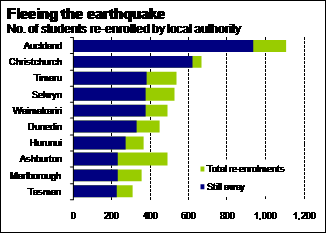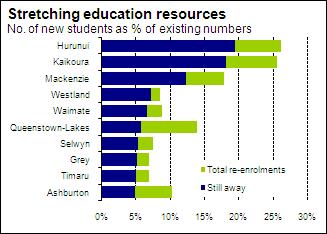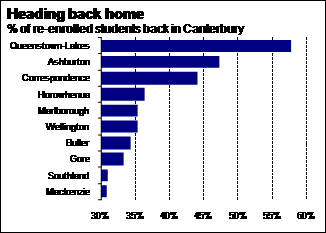Keeping tabs on Christchurch’s population – update April 1
This article updates trends in the re-enrolment of school students from Christchurch and surrounding areas following the quake in February.
Read our original article here
Another 387 students from the quake zone-enrolled in other schools around the country in the week to March 30, taking the total number of re-enrolments to 9,318, or 12.2% of the students from the quake zone. The number of re-enrolments was about half the number recorded in the previous week.
Over the past week, another 735 students returned to their original school in the quake zone, which represents moderate drop-off in the inflows back into Canterbury when compared with the previous week. The latest data shows that 25.5% of re-enrolled students are now back at their original school. Once we account for re-enrolments within the quake zone or at correspondence school, the movements still leave 7.2% of the quake zone’s school-age population in other parts of the country.
Our graphs show little change in the trends by local authority over the last week. Graph 1 shows the same ten areas as a week ago are still hosting the largest number of re-enrolled students from the quake zone.

Graph 1
The most significant change shown in Graph 2 is a sizeable lift in the number of re-enrolled students leaving Ashburton and heading back to their original schools.

Graph 2
With schools in Christchurch now generally back in action, Graph 3 shows a significant lift in the proportion of students who had re-enrolled at The Correspondence School returning to their original school. Although there are two North Island areas in the top ten shown on Graph 3, the latest data shows that 28.8% of students who had re-enrolled in the South Island have returned home, compared with 16.4% of students who had re-enrolled in the North Island.

Graph 3
In summary, we are getting early indications of a stabilising trend in the population movements. We expect the proportion of students remaining outside the quake zone to continue easing overcoming weeks, although it is likely to be another 2-3 months before it becomes clear what proportion of students will stay away more permanently.
We still have no indication of when international migration data for February will be released. However, we will update our analysis of population movements within New Zealand in a week’s time.




















